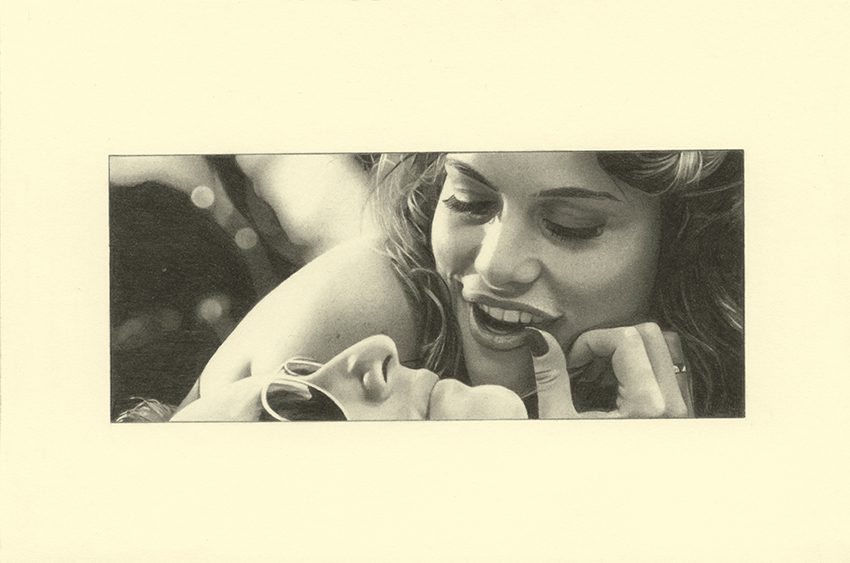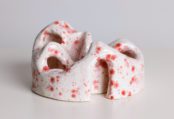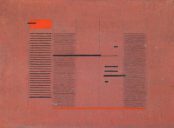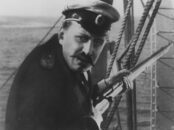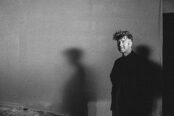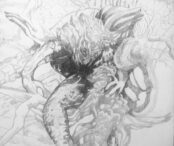London-based artist Marie Harnett makes highly detailed, miniature drawings of transient moments from contemporary cinema. Rendered in a silvery hue, the scenes are imbued with an otherworldly atmosphere that’s both seductive and unsettling.
Here, the artist chats to Millie Walton about her process, temporality and the uncanny.
When did you start using films as your source material?
I’ve always really enjoyed cinema. I think, especially in the last year or so, we’ve all realised how helpful it is to escape and that’s what I really enjoy about films. When I was a student, I worked as an extra on films and was often in period dramas where they made so much effort with the set and costumes, all these tiny details right down to the stockings which often weren’t even going to be visible in the scene. I thought that level of detail was absolutely amazing, but in terms of making a decision to work from film, it was when I was at college. I was quite into comic books, which is also why the drawings started so small. I started making drawings from Sin City, which was a graphic novel that had been turned into a film and I guess I wanted to turn it back into a drawn medium. That was years and years ago. Now, I tend to work from film trailers. I’ll pick out a handful of stills and then, I create my own narratives. So, with the drawings currently on show at the Scottish National Gallery of Modern Art, I wanted to tell a specific story, but more recently, I’ve been using the films just as source imagery and then, changing elements. Films are the launch point for me – I find them so beautiful and forever inspiring.
How do you decide which films or scenes to work from?
It changes. Recently, I’ve been really drawn towards landscapes: trees and fruit, things like that. I think it’s partly because we went to the Rijksmuseum a few years ago and some of the paintings there were just so incredible which planted a seed for my interest in landscape. On the whole though, it tends to be a lot about emotion or an emotional resonance, I guess.
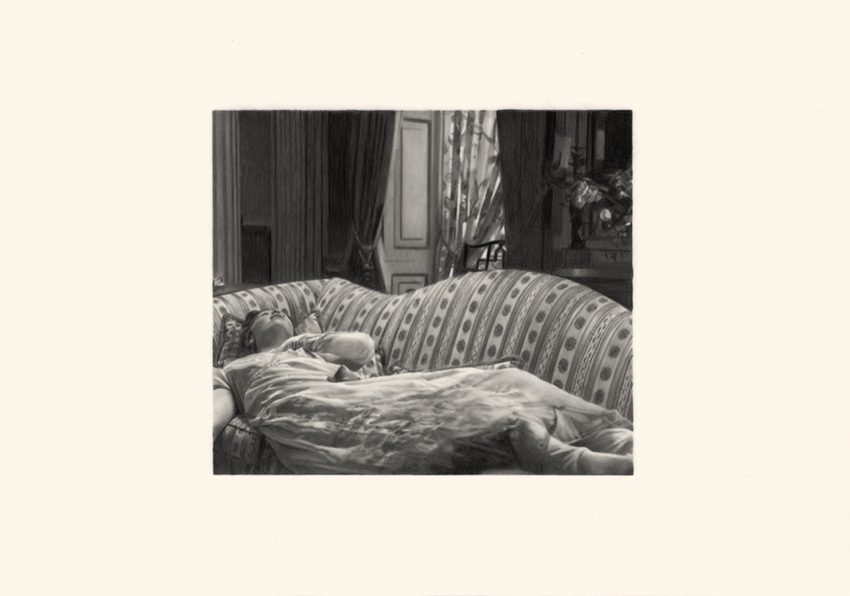
Film stills are a moment frozen in time, which in a way, is quite like drawing. Is that temporality important to you?
Yes, in a number of ways. I think [with the drawings] a lot of people are aware that they are part of a bigger scene or action which has been paused. I really like the fact that it’s a split second frozen, and then the works take me two to three weeks to draw.
A while ago, I was part of a show that was based on the film Last Year in Marienbad which was the museum director’s favourite film so he’d seen it a number of times. I did a drawing of a briefcase, which was just this tiny moment in the film, and the director said that he watched it twice through to try and find that moment but he still couldn’t. I like the fact that I can highlight these things that are usually missed, that I’m making something fleeting more permanent.
You mentioned you work from trailers, so does that mean you don’t need a knowledge of or connection with the film as a whole?
No, I don’t. In fact, in the past, I never wanted to see a film that I thought looked visually interesting. I would watch the trailers in black and white without any sound to deliberately not get any sense of the story and if I thought a film looked good, then I couldn’t watch it for like four years or so. That’s changed now though because I’m moving away from creating narratives. By that I mean, I used to make a series of drawings, between five and ten, which would be shown as a set, whereas now I’m creating standalone works.
Going back to your process, do you print out your selected frames? Or have an archive that you work from?
So, every now and again, I’ll go through a whole batch of trailers in black and white without any sound and if there’s something I think is quite interesting, I’ll make a note of it. For example, at the moment I’m developing a new body of work and I’m looking for more surrealist stuff, something a bit spooky, so that’s in the back of my mind when I look through the trailers that I’ve previously earmarked. If I then think a film could work, I’ll go through it again, frame by frame. Usually, I end up saving around 300 stills per trailer and then, I pull out certain images to work from. So, for the show in Scotland, I did five drawings from one trailer.
Once I’ve saved these stills, I play around a bit on the computer and sometimes, I’ll remove elements or change them. I always used to work landscape but now I’m doing some portrait works to shake it up a bit. I tend to work at a very small scale so maybe 10 centimetres or so across, but every now and again, I’ll do a big, 2-metre drawing. But going back to your question, yes, I do print out my chosen image and I then stick that printed image down and draw below it. As I said before, it’s a slow process. I sit there with an audiobook playing, in my magnifying goggles, with a big cup of tea and I just feel so content.
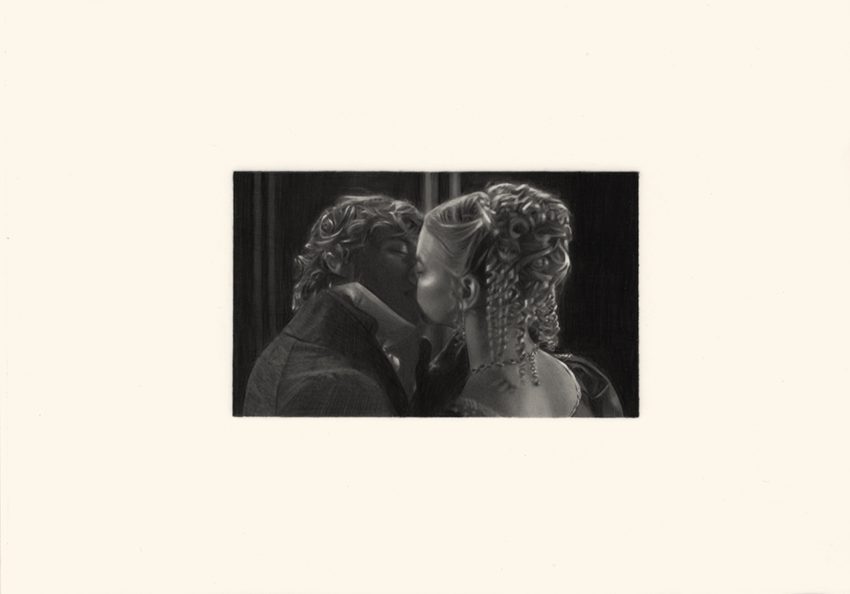
Is it the slowness of the medium that you enjoy?
Yes. I mean it’s not like drawing has been my lifelong love. When I was at college, we had to do drawing two days a week and the tutor told us to approach it like you would approach a painting, to think of it as a finished medium and not just something you sketch before you do the proper work. I think that helped me tremendously and I ended up falling in love with it because it’s got this incredible silvery gleam. If you tilt the drawing in daylight or in any light really, it glows. I also like that you know what you’re gonna get with drawing. So, with painting, which I also really love, you can’t ever be too sure what you’re gonna get, but a pencil mark is more certain and you can always erase it if you don’t like it. You can also take drawings anywhere, which is great when I’m travelling. I can draw quickly if I want to, but I like to draw in a more slowed down, detailed way. I find it very soothing.
Do you think there’s an inherent relationship between drawing and cinema?
I haven’t actually thought about that very much before, but I have seen documentaries where they create storyboards and often sketch out the characters or how a scene is going look. I think drawing underpins a lot of things, it’s a very versatile medium.
Would you say that your process is primarily one of translation?
Yes, for sure. I’m always aware that the image I’m working from is somebody else’s brilliant creation and I hope I do it justice while also putting my own spin on it, which is why I like cropping it down or removing elements.
How do you think working in black and white impacts the image?
As I’m drawing images from films which people can recognise, I think the black and white adds another layer of remove, or a certain distance. So, when people are looking at a drawing they don’t just see it as an illustration, they see it as a standalone artwork. I have a filter on my computer so everything is turned greyscale, but if I take the filter off, I suddenly see all of these colours in a very intense way – lime greens and purples. I do miss working in colour sometimes. Colour is life, really.
Yes, which makes some of your drawings feel a little unsettling.
I think there’s something kind of nice about being a bit unsettled when you see a work. My drawings are very small so you can’t really see them from across the room. You have to go up close and get quite intimate with the image, two people can’t look at the same drawing. So, I think it’s interesting that when you do get up close, and notice there’s maybe a head missing, it can feel a bit spooky or even, intimidating. The strange thing is that people read different themes within the same work. Some people will comment on an image being very romantic and it will surprise me because I will have found that particular still a bit creepy, but I really like that everyone brings their own story to an artwork. However, I am definitely drawn to a slightly surreal atmosphere and have been quite influenced by surrealist women artists like Dorothea Tanning.
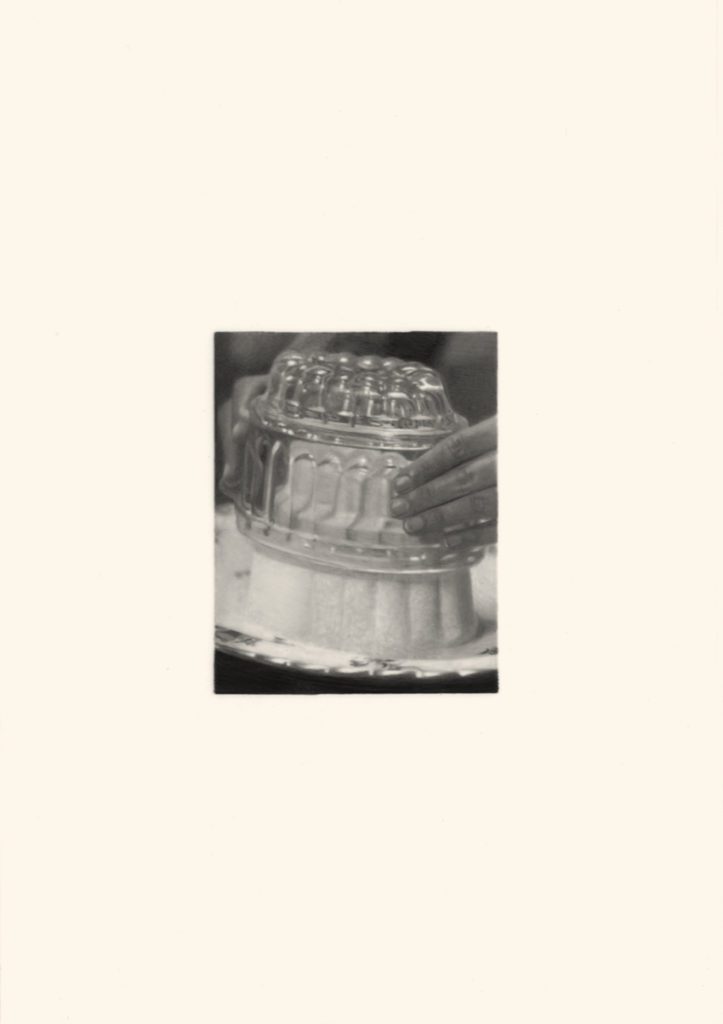
When there’s a head or something missing in the drawing, is that a deliberate choice or more a question of scale?
Sometimes, I’ll choose to put the background where a face should be or crop the scene to a very close scale. For example, I made this drawing of a scene where there are all these people are crammed around a table and they’re focused on this jelly mould at the centre. I cropped it very tightly so it just focused on the hands lifting the mould. It’s not always a question of portraying the still in exactly the same way, but more about highlighting things we wouldn’t usually focus on.
Is the small scale of the works a necessity because of the detail?
The scale came about because I was into comic books and I really liked the little frames they use, but I also picked up a little vintage photo album at a car sale which had these tiny photos that I thought felt so precious. I also remember seeing the Chapman brothers’s Goya etchings at the Turner prize which weren’t tiny, but they felt like a film strip and that really tied things together for me. I do play around with size a lot though, and spend time thinking whether something should be two millimetres smaller or bigger which obviously doesn’t really matter to most viewers. Sometimes, a drawing will feel too small and cramped and then, I’ll make a larger work, two metres or so, which ties in with the idea of the cinema screen, I suppose.
Do you abandon work during the process?
Yes, all the time. There are a few that I’ve started and stopped during the process and there are some that I’ll finish and then feel unsatisfied with it. They go into a drawer. But what I find interesting is that an image might work on a screen or when it’s printed out, but it changes quite dramatically once it’s drawn. For me, the work has to have a bit of magic. It has to feel right.
In previous exhibitions, your works have often been assembled in groups or pairs. Do you think about those connections and how they’ll be viewed when you’re making the drawings?
If it’s a series, I’ll have an order I like them to be in. Having said that, it is interesting when the works have gone to an exhibition and the curator will have another layout in mind. I’m always open to those ideas, especially from people who are experts in their field and might have different insights. But I definitely do imagine them in a certain way and to a certain extent, I draw them to be seen in a certain way. There was one show where they hung the works in a vertical line, which I thought worked very well and hadn’t considered doing before. They were all drawings from the same film.
Do you ever mix up the narratives?
When they’re being shown as a group, it’s always the same film. With the show I recently had at Cristea Roberts, there were two or three films, but nothing was shown as a set. There were some pairings, but generally, it was a bit more individual and playful.
What’s coming up for you in 2022?
I’ve got a group show opening in Amsterdam. It was meant to be this year and now, it’s due to happen in Spring 2022 – hopefully, it will go ahead. The show is based on figuration and film. I’m also working with a friend of mine who’s a curator on developing an exhibition that’s based on film, although we’re really struggling to pick a film at the moment. Then, the show in Edinburgh runs for a year, or something like that. I’m going up to see it next month and really can’t wait. It looks like an amazing collection of work.
Marie Harnett’s work is currently included in “New Arrivals: From Salvador Dali to Jenny Saville” at the Scottish National Gallery of Modern Art (Modern One), Edinburgh. For more information, visit: nationalgalleries.org
Featured Image: Marie Harnett, Silvia, 2013. Courtesy of the artist.

Millie Walton is a London-based art writer and editor. She has contributed a broad range of arts and culture features and interviews to numerous international publications, and collaborated with artists and galleries globally. She also writes fiction and poetry.

